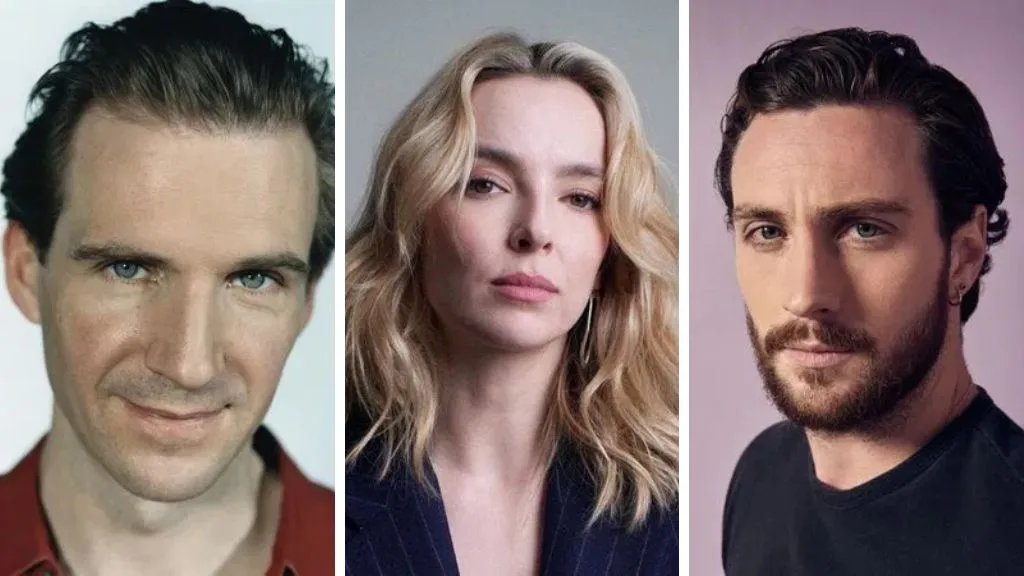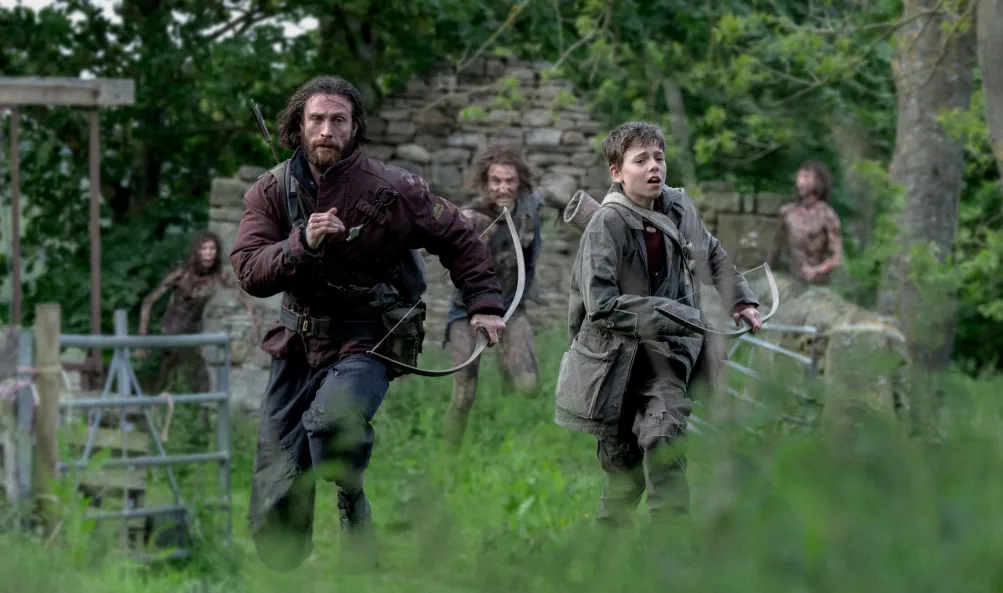The first impressions of 28 Years Later are dominated by an immediate atmosphere of tension and mystery, right from the opening minutes. The keyword that defines the entire experience is “survival.” In the prologue, we see children watching the Teletubbies as chaos erupts — a brutal contrast between innocence and terror that prepares the viewer for the emotional and thematic intensity to come.
In the early scenes, it’s clear that Danny Boyle and Alex Garland opted for a type of horror that not only frightens but also provokes thought. These first moments suggest that the dangers in this story are not just physical but symbolic — epidemiological, political, and psychological. We quickly understand that peace is unlikely, even if the setting looks like a post-catastrophe oasis, surrounded by water.
The initial sequence sets the expectation that the film will explore the nuances of the genre, alternating between scares, emotion, and symbolism. What can you expect in the first few minutes? A shocking prologue, rising tension, and a transition into an isolated environment full of contradictions — where survival creates new traditions, but threats never disappear.
The pacing that holds your attention
Under the theme of Narrative and Rhythm, 28 Years Later keeps the viewer hooked from the start. The story splits in two: the first half focuses on Spike’s growth alongside his father Jamie (Aaron Taylor‑Johnson), and then shifts to his journey with his mother, Isla (Jodie Comer), in search of a cure.
The narrative pulses between moments of tension — every encounter with the “infected” sends shivers down your spine — and human drama, especially in the evolving family dynamics. The strategic use of pauses, as a counterbalance to action sequences, creates an almost ritualistic rhythm, echoing a “coming-of-age story in the middle of chaos.”
Evolving Suspense
The plot is not linear but rather episodic in structure. Each step forward — venturing through swamps, crossing fields, rural landscapes — brings new revelations, new characters (like Dr. Kelson played by Ralph Fiennes and the enigmatic Sir Jimmy), and different forms of infected, including the fearsome “Alphas.” This fragmented rhythm keeps viewers engaged without tiring them — a mosaic of horror and discovery.
Infection evolution and emotional Climax
The film introduces new layers to the zombie genre: crawling creatures, sprinting monsters, and even intelligent and brutal “Alphas” — a true upgrade of classic horror. In the climax, Boyle offers an emotional twist, showing that it’s not just about scares: it’s also an emotional journey. The performances, rising tension, and a tense ending form the soul of the story.
The narrative flow of 28 Years Later strikes a balance between physical and emotional horror. Each act adds layers: shocking introduction, precarious adaptation, external challenges, and finally, a confrontation with humanity’s fragility. The promise of a sequel, The Bone Temple, set for January 2026, still lingers in the air.
Cast: Memorable and Distinct Characters

Jodie Comer delivers a moving performance as Isla, a woman physically fragile but spiritually strong. Her journey — from weakness to resolve — is visceral and compelling.
Aaron Taylor‑Johnson is also convincing as Jamie, the hunter-father and provisional leader. His calm authority and poetic tension with Spike add emotional depth to the story.
Young Alfie Williams, as Spike, steals the show. His hardened innocence and natural dialogue with the more seasoned actors are among the film’s highlights.
Ralph Fiennes, as Dr. Ian Kelson, surprises with a character blending sweetness, madness, and philosophical clarity — his “memento amori” speech moved both critics and audiences.
Jack O’Connell appears after a flashback near the end, with a persona inspired by Jimmy Savile — enigmatic and disturbing, giving the story a political and absurd tone that leaves a lasting impact.
All of these actors bring impressive backgrounds. Comer captivated in Killing Eve, Fiennes in Schindler’s List, and Taylor‑Johnson in Kick‑Ass and Godzilla. This depth shines through in how they embody complex characters here. Alfie Williams, in his film debut, stands out and shows great promise for the future.
Visuals and Cinematography that catch the eye
Danny Boyle brings back idyllic scenes of fields and forests on the northern English coast — beautiful yet foreboding. The contrast between lush nature and constant danger is a visual shock that both pleases and unsettles.
The soundtrack by Young Fathers is as disturbing as the setting. Industrial sounds and ethereal voices accompany tense moments — a sonic pairing that amplifies the drama and horror, even without reusing classic themes from previous films.
The atmosphere feels almost ritualistic. There’s a religious tone, biblical allegories, and symbols (crosses, cemeteries) that give the plot symbolic weight. The occasional use of smartphone footage — arched panoramas, flickering images — adds a modern and chaotic texture to key scenes.
Connections to the Trilogy
The film respects the DNA of 28 Days Later and 28 Weeks Later, but it charts a different path. Here, raw violence gives way to emotion and nuance, without losing intensity.
The story evokes echoes of Shakespeare, Kipling, biblical symbolism, and even nods to contemporary political themes, such as British isolation after major social collapses.
The film’s visual and emotional tone is reminiscent of Prometheus, in its ambition, and Civil War, in its raw and documentary-like approach. The comparison fits: both balance grand visuals with deeply layered storytelling.
Watch 28 Years Later online on the YouCine APK!
28 Years Later is more than just another zombie horror flick — it’s a work that blends horror, family drama, and symbolism within a military-rural setting that explores what remains of humanity. The emotional intensity delivered by performances from Jodie Comer, Ralph Fiennes, and especially Alfie Williams makes this a film to remember. The cinematography, the soundtrack, and the bold storytelling round out a powerful cinematic experience.

Now, imagine watching 28 Years Later on YouCine, the platform that offers a premium, ad-free experience in HD, Full HD, 4K, and 1080p. You can stream it all directly on your phone, computer, TV box, Smart TV, or even your Fire TV Stick — all with smooth performance and ease.
YouCine features a user-friendly interface and supports multiple languages, including Portuguese, English, and Spanish, with both dubbed and subtitled content. Best of all, a single subscription gives you simultaneous access on mobile, TV, and browser. Watch how you want, where you want, with total freedom and comfort.
Besides movies like 28 Years Later, you’ll also find series, animes, cartoons, and even live broadcasts of the world’s best soccer championships. And with the option to mirror content directly from your phone — plus zero adult content — YouCine becomes the perfect platform for the entire family.
So what are you waiting for? Download the YouCine APK now and dive into this universe of brand-new cinema releases, breathtaking series, and live soccer. The ultimate viewing experience is just one tap away — and it all begins with 28 Years Later.
